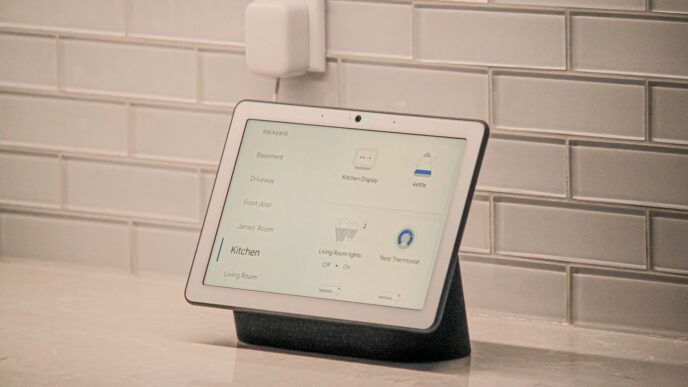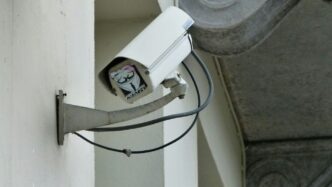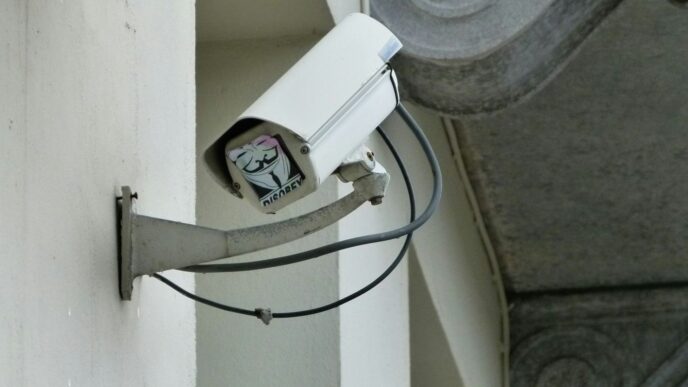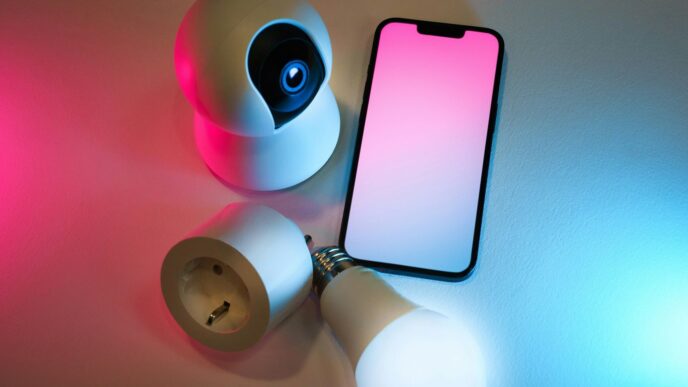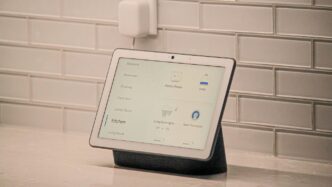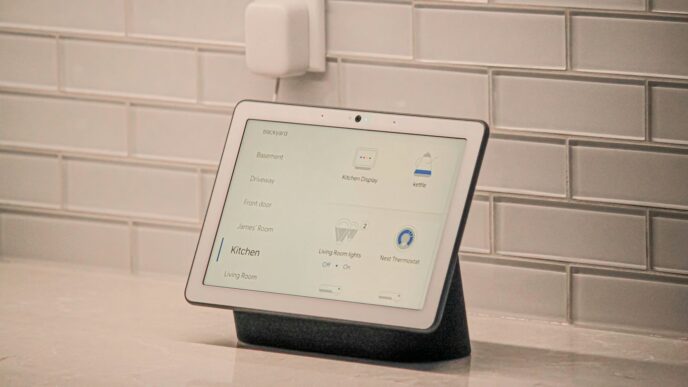Thinking about making your home a bit more modern and easier to manage? You’re not alone. We’re looking at some fresh home automation ideas for 2025 that can make everyday life smoother. From keeping your place secure to just making things more comfortable, there are a lot of simple ways to get started. Let’s check out some of the cool things you can do.
Key Takeaways
- Smart locks provide easy control over who enters your home, offering peace of mind and convenience.
- Automated lighting, like pressure-sensitive strips, can help you move around safely at night without disturbing others.
- Smart appliances and laundry reminders can help manage household chores more efficiently.
- Intelligent lighting systems can create different moods and help you wake up more gently.
- Smart thermostats and window sensors help manage your home’s temperature, saving energy and keeping you comfortable.
Enhance Home Security With Smart Automation Ideas

Thinking about making your home a bit safer? Smart automation can really help with that, and it’s not as complicated as you might think. It’s all about setting up your devices to work together so they can watch out for your place when you’re not around or even when you are. The goal is to have your home actively helping to keep things secure.
Smart Locks for Effortless Access Control
Forget fumbling for keys. Smart locks let you lock and unlock your doors using your phone, a keypad, or even your voice. You can give temporary access to guests or service people, and you’ll always know who’s coming and going. Plus, you can set them to lock automatically at certain times, like when you go to bed, or even when you leave the house.
- Remote Locking/Unlocking: Lock up from anywhere if you forget.
- Guest Access: Grant temporary entry codes for visitors.
- Activity Logs: See who unlocked the door and when.
- Auto-Lock: Set doors to secure themselves after a set period or when you leave.
Intelligent Doorbells for Enhanced Awareness
Smart doorbells are like having an extra set of eyes on your front porch. They have built-in cameras and two-way audio, so you can see and talk to anyone at your door, even if you’re not home. This is great for deliveries or just knowing who’s stopping by. Some can even flash your lights when someone rings the bell, making sure you don’t miss them, especially if you’re wearing headphones or the doorbell is out of earshot.
- See and Speak: Two-way audio lets you chat with visitors.
- Motion Alerts: Get notified when someone approaches your door.
- Package Detection: Some models can tell you when a package is delivered.
- Visual Notifications: Link to lights or smart speakers for alerts.
Automated Doors for Weather Protection
While not strictly security, automated doors, especially garage doors, can add a layer of convenience and protection. Imagine your garage door closing automatically after a certain time or when you arm your security system. This prevents accidental openings and keeps your home secure. Some systems can even be linked to weather alerts, closing garage doors if heavy rain or wind is detected, protecting your vehicles and belongings from the elements.
Optimize Your Living Space With Smart Home Automation
Making your home work smarter, not harder, is the name of the game in 2025. It’s about creating spaces that adapt to you, making everyday life smoother and more comfortable. Think about how much time we spend just… living in our homes. Automating certain aspects can really free up mental space and make things feel more relaxed.
Pressure-Sensitive Lighting for Nighttime Navigation
Ever stumbled around in the dark trying to find the bathroom or a glass of water? Pressure-sensitive lighting is a neat trick for this. Imagine thin light strips installed under your bed or along hallways. When you step on the floor, they gently light up, guiding your way without you having to fumble for a switch. They usually turn off after a set time or when no pressure is detected, saving energy and preventing that jarring brightness when you’re half asleep. It’s a subtle but really useful feature, especially if you have kids or older folks in the house.
Smart Rebooters for Device Reliability
We’ve all been there: your Wi-Fi drops, and suddenly half your smart gadgets go offline. Then comes the fun part – unplugging and replugging each one, often in hard-to-reach places. A smart rebooter, essentially a smart plug with a bit more brains, can fix this. You can set them up to automatically restart devices if they lose connection or even schedule regular reboots. This keeps your smart home running smoothly without you having to play electrician every time the internet hiccups.
Automated Blinds for Ambiance and Energy Savings
Automated blinds are more than just a fancy gadget; they can actually change how your home feels and how much you spend on heating and cooling. You can program them to open with the sunrise, letting natural light fill your rooms, or close them during the hottest part of the day to keep the heat out. This simple automation can make a noticeable difference in your home’s temperature and your energy bills. You can even set them to close automatically when you start watching a movie for that perfect home theater vibe. It’s all about making your living space more responsive to both your needs and the environment outside.
Streamline Daily Chores With Home Automation Ideas
Let’s face it, nobody really enjoys doing chores. But what if technology could take some of the load off? Home automation isn’t just about fancy gadgets; it’s about making everyday tasks simpler and freeing up your time. Imagine a home that helps you manage your household without you even thinking about it.
Smart Appliances for Remote Control
Remember that sinking feeling when you’re halfway to work and can’t remember if you turned off the oven? Smart appliances put an end to that worry. You can check the status of your oven, refrigerator, or even your coffee maker right from your smartphone. Need to preheat the oven for dinner? You can do that from your office. Running low on milk? Some smart fridges can even alert you and add it to your shopping list. It’s like having a personal kitchen assistant, always on call.
Laundry Reminders and Task Management
Laundry is one of those never-ending tasks. Smart home systems can help keep it under control. You can set up notifications to remind you when a load is done, so clothes don’t sit around getting musty. Some advanced systems can even track how many cycles your washing machine has completed and remind you when it’s time for maintenance. Beyond laundry, you can integrate task management apps with your smart home. For example, when you tick off a chore on your digital to-do list, a smart dispenser could even give your pet a treat – a little reward system for getting things done!
Automated Cleaning with Robot Vacuums
Robot vacuums have come a long way. These aren’t just novelty items anymore; they’re genuinely helpful tools for keeping your floors clean. You can schedule them to run while you’re out of the house or even while you sleep. Many models can map your home, avoid obstacles, and return to their charging station automatically. Some can even empty their own dustbins into a larger base, meaning you only have to deal with emptying the base every few weeks. It’s a set-it-and-forget-it solution for daily floor maintenance.
Create Ambiance With Intelligent Lighting Automation
Lighting is more than just about seeing. It sets the mood, influences how we feel, and can even help us wake up or wind down. Smart lighting automation takes this a step further, letting you control your home’s atmosphere with ease.
Customizable Lighting Scenes for Every Mood
Think about setting the perfect scene for any occasion. You can create presets for "Movie Night" with dim, warm lights, or "Dinner Party" with brighter, more inviting tones. These scenes can be activated with a single tap on your phone or even a voice command. It’s like having a personal lighting director for your home.
Here’s how you might set up a few common scenes:
- Relaxation: Dim lights to 20%, warm white color temperature (around 2700K).
- Reading: Brighter lights (60-70%), neutral white (around 3500K), focused on your reading area.
- Morning: Gradually increasing light from 0% to 40% over 15 minutes, starting around 6:30 AM on weekdays.
Motion-Activated and Sensor-Based Illumination
No more fumbling for light switches in the dark. Motion sensors can turn on lights as you enter a room and turn them off after a set period of inactivity. This is super handy for hallways, bathrooms, or closets. You can even link door sensors to turn on porch lights when the front door opens after sunset. It adds a layer of convenience and can also help with security by making it look like someone’s home.
Smart Wake-Up Lights for Gentle Mornings
Dragging yourself out of bed can be tough, right? Smart wake-up lights simulate a sunrise, gradually increasing brightness before your alarm goes off. This gentle approach can help you feel more rested and less groggy. You can set this up using a smart bulb or a smart dimmer switch. It’s a much nicer way to start the day than a jarring alarm clock.
Leverage Smart Technology for Climate Control
Keeping your home at just the right temperature can make a big difference in how comfortable you feel, and also how much you spend on energy bills. Luckily, smart tech makes this way easier these days.
Smart Thermostats for Energy Efficiency
Forget fiddling with that old dial thermostat. Smart thermostats are pretty neat. They learn your schedule, so they know when you’re usually home and when you’re out. This means they can automatically adjust the temperature to save energy when you don’t need the heating or cooling on full blast. You can also control them from your phone, so if you’re heading home early, you can warm up or cool down the house before you even walk in the door. Some even give you reports on your energy usage, showing you where you can save more.
Here are some things to look for:
- Learning Capabilities: The thermostat learns your habits over time to cut down on waste.
- Remote Access: Control your home’s temperature from anywhere using an app.
- Energy Reports: See how much energy you’re using and find ways to save.
- Integration: Connects with other smart home devices for better overall efficiency.
Automated Bathroom Fans for Air Quality
This one might seem a bit niche, but it’s surprisingly useful. You know how sometimes the bathroom gets a bit steamy after a shower? An automated bathroom fan can take care of that. It can be set to turn on automatically when it detects humidity or even just on a timer after you’ve used the shower. This helps keep the air fresh, prevents mold and mildew buildup, and generally makes the bathroom a more pleasant space. It’s a small automation that really helps with home maintenance and air quality.
Window Sensors for HVAC Optimization
This is another clever way to make your heating and cooling system work smarter. Window sensors are small devices you attach to your windows. When a window is open, the sensor tells your smart thermostat or HVAC system to pause. Why? Because there’s no point in heating or cooling your house if you’re just letting all that conditioned air escape out the open window! It’s a simple trigger that can prevent a lot of wasted energy and money, especially if you have a habit of forgetting to close windows before turning on the AC.
Integrate Smart Hubs and Assistants
To really make your smart home work, you need a way for all those gadgets to talk to each other. That’s where smart hubs and voice assistants come in. Think of a hub as the central brain for your smart home. It connects all your different devices – lights, locks, thermostats, you name it – so they can work together. Without one, you might end up with a bunch of cool gadgets that don’t actually do much together.
Centralized Control With Smart Panels
Smart panels are like a command center for your home. They often look like a tablet mounted on the wall, and you can use them to see and control everything. Some panels can even show you energy usage, which is pretty neat if you’re trying to keep an eye on your electricity bill. When you’re picking one out, think about whether you might want to add more devices later. A good panel will let you expand your system without a fuss.
Voice Command Integration With Smart Speakers
Voice assistants, like those from Google or Amazon, have become super popular. You can just talk to them to get things done. Want to turn off the lights? Just ask. Need to know the weather? Ask away. They’re great for simple tasks and can be programmed to do more complex routines. For example, you could say "Good morning," and have your lights turn on, the thermostat adjust, and your favorite news station start playing.
Here’s a quick look at how some popular voice assistants stack up for smart home tasks:
| Assistant | Voice Recognition | Responses to Commands | Routines and Automation |
|---|---|---|---|
| Google Assistant | 8.5 | 8.0 | 8.2 |
| Amazon Alexa | 7.7 | 7.1 | 7.5 |
| Apple Siri | 7.6 | 7.2 | N/A |
Connecting Devices for Seamless Automation
Getting devices to connect is the main goal. You want your smart home to feel like it’s working for you, not the other way around. This means checking compatibility before you buy. Does that new smart plug work with your existing hub? Will your smart bulbs connect to your voice assistant? It’s worth looking into the specs. Some hubs support a lot of different brands and communication types, like Wi-Fi, Zigbee, and Z-Wave. The better the compatibility, the fewer headaches you’ll have down the road. Ultimately, the right hub and assistant setup makes your smart home truly smart.
Innovative Home Automation Ideas for Outdoor Spaces

Our homes aren’t just about what’s inside anymore. We’re spending more time outdoors, and making those spaces smarter can really change how we use them. Think about your backyard, patio, or even just the area around your garage – there are ways to automate things out there too.
Smart Lighting for Play Areas
Remember fumbling for light switches when heading out to the basketball court or patio after dark? You can link your outdoor lights to motion sensors or even your security cameras. This means lights come on automatically when someone enters the area, and turn off after a set period of inactivity. It’s great for kids playing outside or if you’re just enjoying a late evening on the deck. No more tripping in the dark or leaving lights on all night by accident.
Weather-Aware Automated Outdoor Shades
Sudden gusts of wind or a surprise rain shower can ruin outdoor plans. You can set up automated outdoor shades, like pergolas, that react to weather changes. Connect them to a weather station or a smart home hub that monitors wind speed and rain. If the wind picks up beyond a certain point, say 25 miles per hour, the shades can automatically lower to protect your furniture and prevent damage. This is a pretty neat way to keep your outdoor living space ready for anything. You can find some great options for automated pergolas that integrate well with smart home systems.
Fresh Air Alerts for Healthier Living
It sounds a bit futuristic, but you can get alerts to remind you to step outside and get some fresh air. By connecting your home assistant to outdoor sensors or even security cameras, you can get a nudge when the weather is pleasant and no one’s been detected outside for a while. It’s a simple prompt to take a break, get some sun, and breathe in some fresh air, which is good for both physical and mental well-being. It’s a small thing, but it can make a difference in your daily routine.
Wrapping Up Your Smart Home Journey
So, we’ve looked at a bunch of ways to make your home work smarter, not harder. From lights that know when you need them to systems that keep an eye on the weather, there’s a lot out there to make life a bit easier. It might seem like a lot at first, but you can start small. Pick one or two things that sound useful and see how they fit into your routine. The goal is just to make your living space more comfortable and maybe save a little time or energy along the way. It’s all about finding what works for you and your home.
Frequently Asked Questions
What’s the easiest way to start making my home “smart”?
You can begin with simple things like smart lights or a smart speaker. They’re usually easy to set up and use right away. Think of them as the first steps to a more connected home.
Do I need to replace all my old appliances to make my home smart?
Not at all! You can start by using smart plugs with your existing appliances. This lets you control them with your phone or voice, making them ‘smart’ without buying all new ones.
Can smart home tech really help me save money on bills?
Yes, definitely! Smart thermostats learn your habits and adjust the temperature to save energy when you’re away or asleep. Smart lights can also turn off automatically when a room is empty, cutting down on electricity use.
Is setting up a smart home complicated?
It can seem like a lot at first, but most systems are designed to be user-friendly. You can start small with just a few devices and add more over time as you get comfortable. Many apps guide you through the setup process.
How do smart locks make my home safer?
Smart locks let you lock and unlock your doors from anywhere using your phone. You can also give temporary access to guests or delivery people. Plus, you can check if your doors are locked even when you’re not home, so you don’t have to worry about forgetting.
Can smart home devices work together, or do I need separate apps for everything?
Many smart devices can work together through a central ‘hub’ or a smart assistant like Alexa or Google Assistant. This means you can control multiple devices with a single command or set up automations, like having the lights turn on when you unlock the door.




